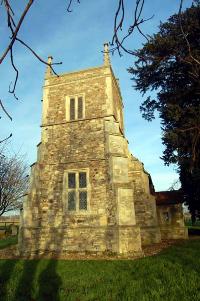
Hulcote church February 2007
Volume 81 published by Bedfordshire Historical Records Society (2002) is a series of episcopal visitations undertaken in the first twenty years of the 18th century, edited by former County Archivist Patricia Bell. At each visitation a list of questions was sent out in advance, one of which enquired about the provision of schools in each parish. In 1706 the return stated: "There is neither lecture, Schole, Almes-house, nor Hospital in this parish". In 1717 the return simply stated: "No school".
In 1818 a Select Committee was established to enquire into educational provision for the poor. This was no doubt prompted, in part, by the recent foundation of two societies promoting education and specifically the building of schools. The Society for Promoting the Lancasterian System for the Education of the Poor was established in 1808 promoting schools run along the lines pioneered by Joseph Lancaster, who had himself copied those of Dr. Andrew Bell, in which older children taught their younger fellows. The Society was renamed the British and Foreign School Society in 1814. It was supported by a number of prominent nonconformists, Lancaster himself was a Quaker, and sought to teach a non-sectarian curriculum. In answer to this perceived nonconformist takeover of local education the National Society was formed in 1811 to encourage the teaching of poor children along Anglican lines, including the catechism. The Select Committee sent a questionnaire to all parishes in the country asking for: particulars relating to endowments for the education of children; other educational institutions; observations of parish needs etc. The response from Hulcote stated that there was no daily school but there was a Sunday school containing about twenty boys and thirty six girls "open to this parish and that of Salford". In those days a Sunday school was just that, a school which met on a Sunday, usually in the church or nonconformist chapel or other similar building, teaching more than the religious topics with which they are associated today.
In the country generally the number of schools built continued to grow over the next fifteen years so that by 1833 the government agreed to supplement the work of the two societies, and local benefactors, by making £20,000 per annum available in grants to help build schools. It also prompted another questionnaire to be sent to each parish in England asking for details of local educational provision. The response from Hulcote was simply: "No School in this Parish".
The next national enquiry was in 1846/7 when the Church of England made an enquiry as to all its church schools. This was against the background of a new Whig government which championed secular education and the increasing importance of nonconformists, particularly Wesleyan Methodist, and Roman Catholics in providing schools. The response for Hulcote was combined with that for Salford. The Sunday school was still in existence, now with twenty six boys and thirty six girls. The Rector noted: The school is supported by the Rector entirely. The children go to work at so young an age, that a Day school would not be attended".
The first Education Act was passed in 1870 (more correctly it was known as the Elementary Education Act). It was a milestone in the provision of education in Britain demonstrating central government's unequivocal support for education of all classes across the country. It also sought to secularise education by allowing the creation of School Boards. These were groups of representatives, elected by the local ratepayers and the Board had the powers to raise funds to form a local rate to support local education, build and run schools, pay the fees of the poorest children, make local school attendance compulsory between the ages of 5 and 13 and could even support local church schools, though in practice they replaced them, turning them into Board run schools (known as Board Schools). Naturally, and luckily for local historians, the Act required a questionnaire of local schools in 1870. The response from Hulcote was: "School without the district but available for it. Salford-cum-Holcote National School at Salford, providing 15 places".
Hulcote has always been too small a settlement for a school of its own. Its children went to Salford School until that institution closed in 1952. There are lower schools in the neighbouring parishes of Cranfield and Houghton Conquest and a middle school in Cranfield.